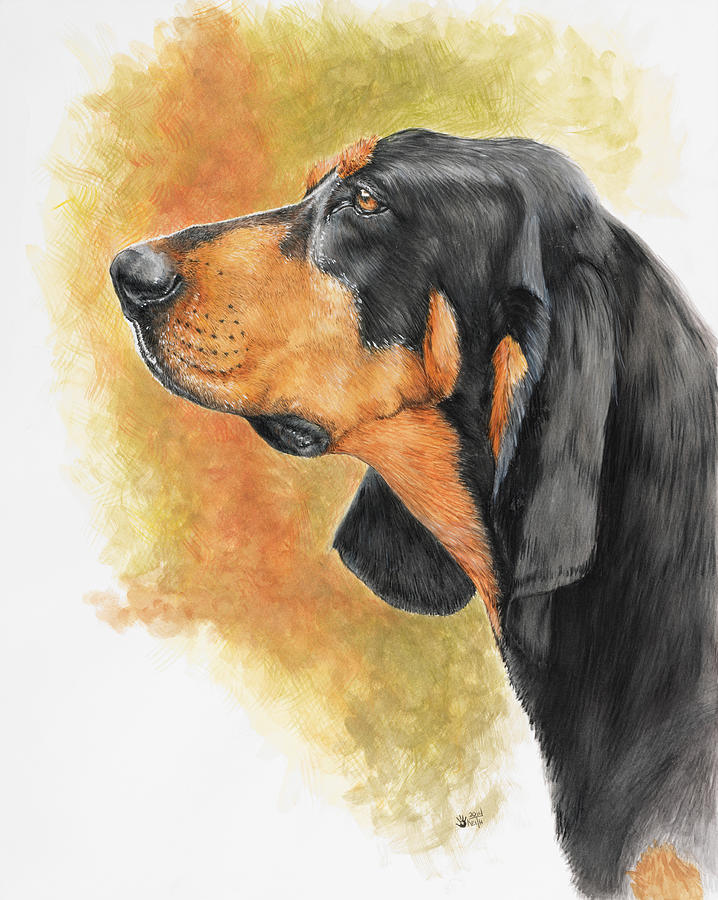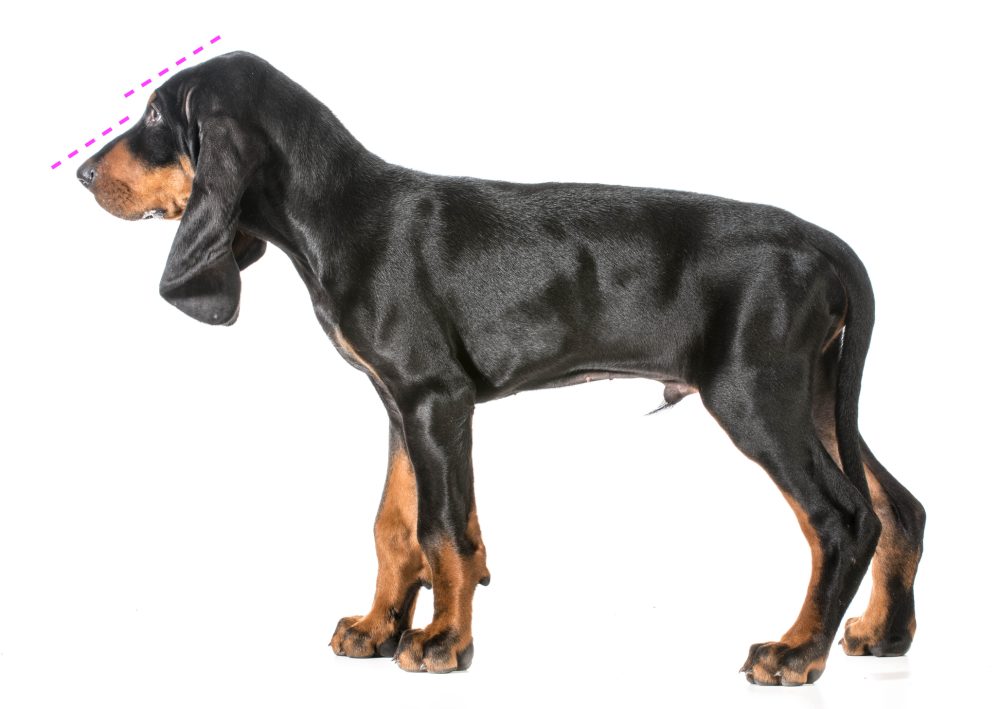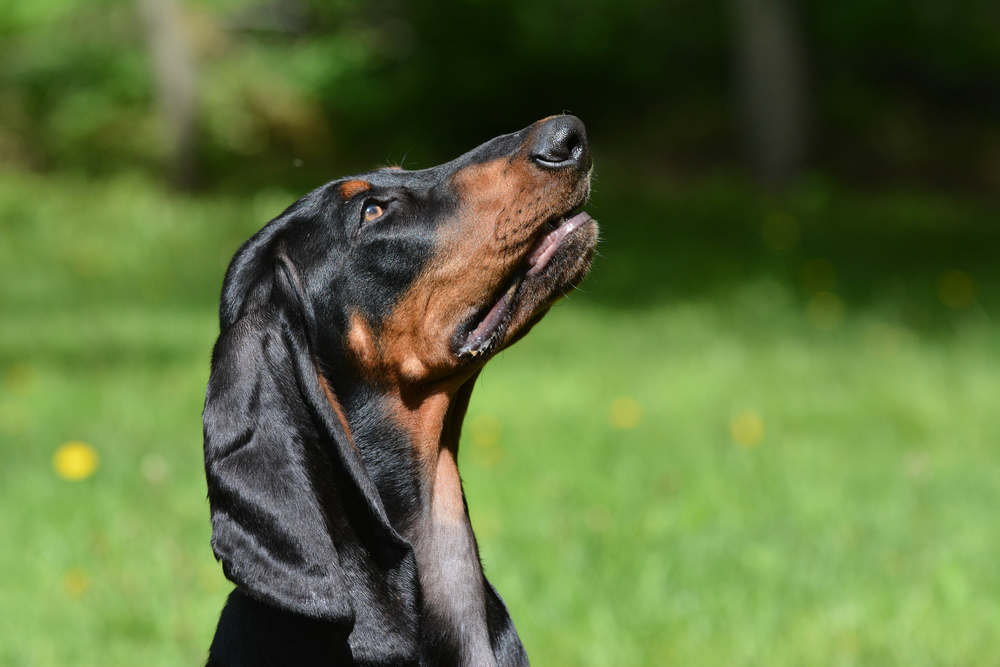
If it seemed to longtime dog fanciers that Coonhounds were added to the AKC family in a flurry, they weren’t entirely wrong. Between 2009 and 2012, four Coonhound breeds were recognized, but curiously, the very first Coonhound breed accepted way back in 1945 is said by some to be the least common of the five, and that is the Black and Tan Coonhound. The B&T, some say, has more limited presence in both hunting circles and as a companion dog, but AKC registration numbers from 2023 don’t support the claim. In fact, the Black and Tan appears higher in popularity for 2023 (sitting at #131) than the Bluetick Coonhound (#139), the Redbone (#140), the Treeing Walker Coonhound (#155) and the Treeing Walker Coonhound at #178.
Born when frontiersmen first crossed European hounds, Foxhounds and Bloodhounds during post-Revolutionary times to create a unique American breed, the Black and Tan Coonhound was developed to hunt raccoons and other crop-destroying game in the forests of Appalachia and the southern United States. Over the years, the breed became specialized to scent hunt in the difficult conditions of the American forest, and it is here we pivot to examine why the head of this “smelling machine” is eminently suited for the job.
A slightly domed and broad skull that measures from 9 to 10 inches in males (8 to 9 inches in females) from the back of the skull to the nose provides ample space for the brain and dog’s extensive olfactory system, crucial for tracking prey. When seen from the side, the skull tends to have an oval outline, the skull line about parallel to the topline of dog’s muzzle or foreface. This shape allows for a large nasal cavity and olfactory bulb.

Even in a puppy, parallel head planes are apparent. Black Tan Coonhound photo by © Willeecole | Dreamstime
The head, as the standard writes, is “cleanly modeled.” This simply means that contours and planes of the skull and muzzle are distinct and easily perceptible, but they transition smoothly into each other. Put in highly imaginary terms, if you were to put a marble on the occiput of the dog in the photo above, it would roll gently and slowly before dropping off the end of the nose, not get stuck in the stop of a breed like the Pointer. A “moderate” stop situated midway between the dog’s occiput and the nose allows for optimal positioning of the olfactory organs.
There should be no exaggerated features in the head of a Black and Tan, and you’ll note that the head is free of excessive wrinkles or loose skin, a “clean” framework that allows for the head’s functional “working parts” to be prominent without being impeded by too much flesh. That said, a Black and Tan’s muzzle is well-developed because more surface area provides more scent receptors.

Photo by WilleeCole Photography/
Shutterstock
A Black and Tan’s muzzle is well-developed because more surface area provides more scent receptors, but you’ll also note that the breed has “well open” nostrils. To state the obvious, large, open nostrils allow the dog to take in more air and maximize the amount of scent molecules that can enter the nasal cavity.
It’s easy to bandy about the term, “nasal cavity” a lot because when people hear the word, “nasal,” they know it has to do with smell, but we’re going to get into the weeds to explain why the nasal cavity is so important. It is one word: Turbinates.
Turbinates are complex, maze-like structures that significantly increase a dog’s surface area within his nasal cavity. A larger surface area allows for more olfactory receptors, and those enhance the dog’s ability to detect and analyze scents. Turbinates help direct airflow and ensure that odor molecules come into contact with the olfactory receptors. They create intricate airflow patterns that optimize scent detection.
Anyone who has worked with a trailing dog can tell you that warm air improves scent detection, and once again, turbinates are important. They contain a network of blood vessels that help warm and humidify incoming air, and while doing this helps protect sensitive nasal tissues, it also improves the functioning of the scent receptors by helping separate odors by their weight and solubility. This allows the dog to tell the difference between different scents more effectively.
Turbinate structure also matters because when the dog sniffs, air is inhaled from the front and exhaled to the side, allowing for continuous sampling of new odors.
We can’t leave a discussion about the Black and Tan’s head without addressing one of its most important and lovable attributes: Those magnificent ears.
The ears are set low and well back, and should naturally extend to the tip of the nose. Indeed, show judges are instructed by the Illustrated Guide to penalize ears that do not reach the tip of the nose, or ears set too high on the head. Hanging in graceful folds, the pendulous ears of the Black and Tan Coonhound help funnel scents towards the nose, and as the dog moves, the ears not only act like scoops, directing air and scent particles towards the nasal area, but create small air currents that direct scent molecules to the nose.
We don’t really consider this part of having long ears, but they also help block out some visual distractions, and – in theory – this allows the dog to focus more intently on scent tracking.
We hope we’ve made the case for the marvel that is the Black and Tan Coonhound’s head. We didn’t discuss coat, but we conclude with what we see as the “cherry on top.” They are called, ‘Pumpkin Seeds’ and refer to the rich tan markings above eyes. It seemed a good post title to us.
Image: Black and Tan Coonhound by Barbara Keith
http://barbara-keith.fineartamerica.com
http://barbara-keith.artistwebsites.com/
http://www.redbubble.com
http://www.zazzle.com/barbbarcikkeith
